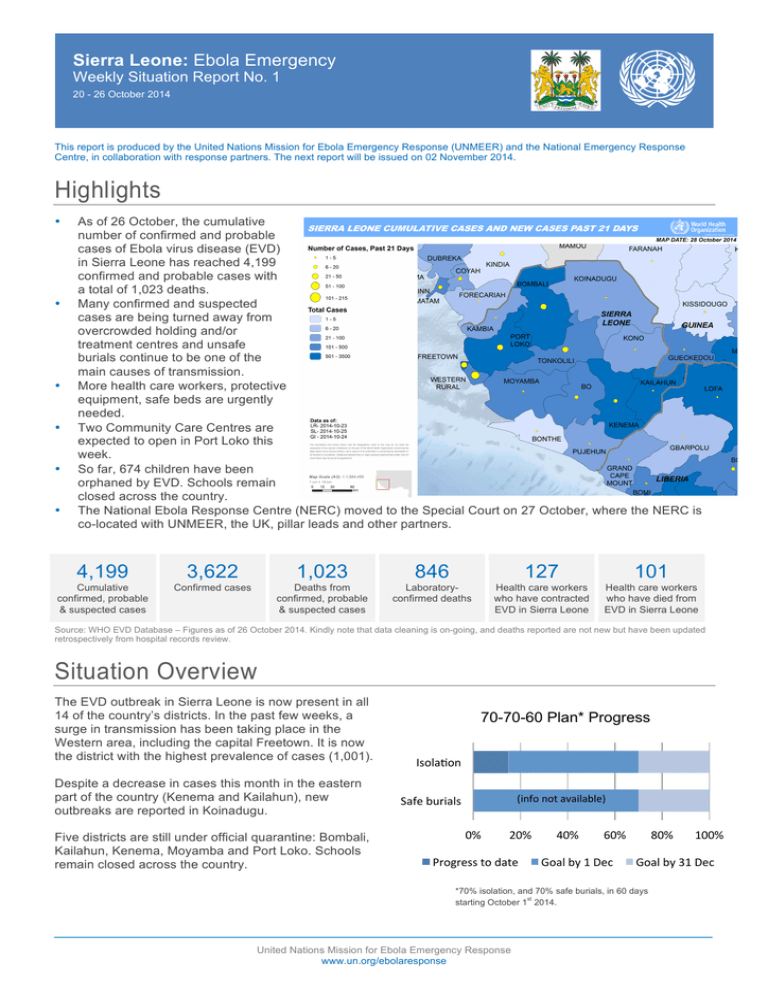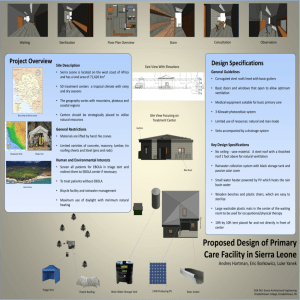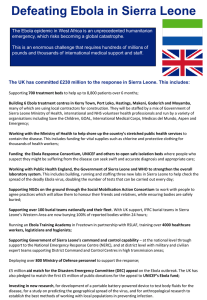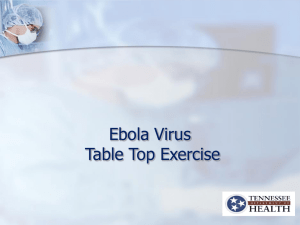Sierra Leone: Weekly Situation Report No. 1
advertisement

Sierra Leone: Ebola Emergency Weekly Situation Report No. 1 20 - 26 October 2014 This report is produced by the United Nations Mission for Ebola Emergency Response (UNMEER) and the National Emergency Response Centre, in collaboration with response partners. The next report will be issued on 02 November 2014. Highlights • • • • • • As of 26 October, the cumulative number of confirmed and probable cases of Ebola virus disease (EVD) in Sierra Leone has reached 4,199 confirmed and probable cases with a total of 1,023 deaths. Many confirmed and suspected cases are being turned away from overcrowded holding and/or treatment centres and unsafe burials continue to be one of the main causes of transmission. More health care workers, protective equipment, safe beds are urgently needed. Two Community Care Centres are expected to open in Port Loko this week. So far, 674 children have been orphaned by EVD. Schools remain closed across the country. The National Ebola Response Centre (NERC) moved to the Special Court on 27 October, where the NERC is co-located with UNMEER, the UK, pillar leads and other partners. 4,199 3,622 1,023 846 127 101 Cumulative confirmed, probable & suspected cases Confirmed cases Deaths from confirmed, probable & suspected cases Laboratoryconfirmed deaths Health care workers who have contracted EVD in Sierra Leone Health care workers who have died from EVD in Sierra Leone Source: WHO EVD Database – Figures as of 26 October 2014. Kindly note that data cleaning is on-going, and deaths reported are not new but have been updated retrospectively from hospital records review. Situation Overview The EVD outbreak in Sierra Leone is now present in all 14 of the country’s districts. In the past few weeks, a surge in transmission has been taking place in the Western area, including the capital Freetown. It is now the district with the highest prevalence of cases (1,001). Despite a decrease in cases this month in the eastern part of the country (Kenema and Kailahun), new outbreaks are reported in Koinadugu. Five districts are still under official quarantine: Bombali, Kailahun, Kenema, Moyamba and Port Loko. Schools remain closed across the country. 70-70-60 Plan* Progress Isola5on (info not available) Safe burials 0% 20% Progress to date 40% 60% Goal by 1 Dec 80% Goal by 31 Dec *70% isolation, and 70% safe burials, in 60 days st starting October 1 2014. United Nations Mission for Ebola Emergency Response www.un.org/ebolaresponse 100% Sierra Leone Ebola Emergency Situation Report No. 01 |2 Funding Funding needed by pillar (in million US$) Sierra Leone Funding Needs: US$ 371 million required Surveillance (estimate based on October planning assumptions) Safe & dignified burials Overall pledges, commitments, and contributions, (including those unrelated to a specific appeal): 216 Case Management Soc. Mob. / Comms. US$ 106 million earmarked Enabling Services 34.1 9.2 17.6 94.3 All humanitarian partners, including donors and recipient agencies, are encouraged to inform OCHA's Financial Tracking Service (FTS - http://fts.unocha.org) of cash and in-kind contributions by e-mailing: fts@un.org Case Management - Pillar leads: MoHS, WHO Ebola Treatment Centres (ETCs) Needs: • An estimated 1604 beds are needed in ETCs to offer treatment to EVD patients, and improve the mortality in a setting that is safe for healthworkers. Each treatment centre is to have a capacity of 50 to 100 beds. 1133 beds are anticipated to be made available by the first week of December. additional ETC beds Each of these facilities is to be managed and staffed by Foreign Medical Teams needed by 1 Dec. (FMTs, composed of 25-35 clinical and infectious disease experts) as well as national staff (200-250 required per facility). WFP and UNICEF are working with the Ministry of Health and Sanitation to ensure that holding and treatment centres are supplied with food rations, including high energy fortified biscuits, infant formula, and milk. 881 • • • Response: • • • • • There are a total of 4 operational ETCs with a total number of 252 beds. Two of these facilities (Kailahun and Bo) are operated by Médecins Sans Frontières (MSF). Ten new ETCs are planned with an additional total bed capacity of about 750. As of 25 October, a total of 196 confirmed cases are currently admitted at the treatment centres in Kenema (24), Kailahun (39), Bo (28) and Western area (105). The Sierra Leonean National Ebola Response Centre (NERC) has approved several standard operating procedures including safe & dignified burials, and home protection & support for transmission mitigation in households. The Sierra Leonean Ministry of Health and Sanitation (MoHS), WHO, UNICEF and partners are conducting Infection Prevention and Control (IPC) assessments in various ETCs to ensure staff and patient safety. Gaps & Constraints: • • • An additional 881 safe beds need to be secured and available by the first week of December. Lack of available beds in ETCs is forcing families to care for patients at home, where caregivers are unable to adequately protect themselves from EVD exposure, thereby increasing transmission risks. The staffing of ETCs with FMTs and national staff remains a major challenge. There are currently 15 FMTs in place ; an additional 3 are needed by 1 December (30 staff total). The need for payment harmonization, the lack of clarity on medical evacuation and hazard pay procedures are impeding the swift hiring and deployment of new international and national staff for ETCs. Community Care Centres (CCCs) Needs: • • In order to achieve the goal of 70% isolation by 1 December 2014, a community-based, holistic approach to isolation is critical. An estimated 200 CCCs − each with an 8-bed capacity − are required. United Nations Mission for Ebola Emergency Response www.un.org/ebolaresponse Sierra Leone Ebola Emergency Situation Report No. 01 |3 Response: • • • • • UNICEF, WFP, Oxfam, DFID, and other partners, are working to scale up the delivery of CCCs. Two are scheduled to open in short order in Port Loko. additional CCCs Standard operating procedures for these facilities are being field-tested by WHO needed by 1 Dec, with staff in Port Loko before rolling out in other districts. 8-bed capacity each. WHO will monitor CCC operations daily, including adherence to PPE, IPCand safe practices. WHO, UNICEF and partners are ensuring that affected communities are consulted in the rollout of CCCs. 56 trainers from the Sierra Leonean Ministry of Defence are now qualified to train new CCC caregivers from their ranks. 198 Gaps & Constraints: • • • An additional 198 CCCs are required by the first week of December. The main challenge in the rapid roll out of CCCs is securing of implementing partners, supplies and training. Precise guidelines on how to use each of the 8 beds available in those facilities need to be established (division between suspected and confirmed cases). Surveillance - Pillar leads: MoHS, UNFPA, CDC, WHO Case Finding and Contact Tracing Needs: • • • 5,000 An approximate total of 5,000 volunteers are required for case-finding and contact volunteers required by tracing to reach the 70% isolation target by the first week of December. 1 Dec It is expected that a 2-person team can cover 40 households in urban areas and 20 households in rural areas. Ambulance teams needed in support of contact tracing and case finding teams for pick-up of suspected cases (composed of 1 dedicated vehicle, 1 stretcher, 2 PPE personnel, 1 communicator, 1 driver). Response • • • • As of 24 October, a total of 25,093 contacts have been listed to date, out of which 13,275 have completed observation time and have been discharged from follow-up. Approx. 90% of contacts are traced by teams daily, particularly by UNFPA, IFRC and CDC teams. Training of new contact tracers is ongoing, particularly by UNFPA. UNFPA is providing the Sierra Leonean Ministry of Health and Sanitation (MoHS) with logistical support for effective case finding (including donation of motorcycles, computers, printers, uninterruptable power supply and GPS devices). Gaps & Constraints: • As the caseload and contacts increase, the number of case finders and contact tracers will need to be scaled up, particularly in urban areas. Laboratories Needs: • • EVD diagnosis to be provided to patient within 24 hours following the collection of samples for adequate treatment, and transmission prevention. With current caseload projections, ten laboratories are required for Sierra Leone, and the sample capacity needs to be scaled up to 1250 samples per day. Response: • • • The current lab capacity is of 5,100 samples/month Currently, 6 laboratories are operating, with a capacity of 250 to 300 samples per day. The US Centers for Disease Control and Prevention (CDC), as well as the Governments of South Africa, Canada and China run these laboratories. The current capacity of these facilities stands between 250 and 1000. At least, two new laboratories are expected to be completed by 1 December. Gaps & Constraints: • • Expected acceleration of CCCs roll-out will increase demand for higher sample testing capacity. Insufficient laboratory capacity is delaying treatment for EVD-affected patients and increasing the risk of infections from EVD to non-EVD patients, in holding centres and during transport. United Nations Mission for Ebola Emergency Response www.un.org/ebolaresponse Sierra Leone Ebola Emergency Situation Report No. 01 |4 Safe and Dignified Burials - Pillar leads: MoHS, IFRC Needs: • • • In order to decrease transmission through unsafe burial practices, an estimated 90 burial teams are required nationally. Each burial team should be composed of approximately 9-12 members including handlers, sprayers, drivers, and one communicator. Additional teams need to be trained to provide a level of dignity to burials, respectful of the families’ wishes, and in accordance with standard operating procedures. Bodies must be removed from their homes within the 24 hours following death. 44 additional safe burial teams are required by 1 December to ensure 100% coverage. Response: • • There are currently 46 burial teams operational around the country, each composed of 5 to 9 members. The International Federation of the Red Cross and Red Crescent Societies (IFRC) is continuously scaling up efforts. Gaps & Constraints: • • • • An estimated 44 additional safe burial teams are required by 1 December to ensure 100% coverage. Behavioural change remains extremely challenging in certain areas. It is suspected that many EVD burials are taking place without alerting the authorities and partners. The time needed to conduct laboratory analysis and transport samples/results is causing safe burial teams are required to cover not only confirmed cases, but also suspected and probable cases. The current standard of practice for safe burials requires that removal of the body be followed by a decontamination process, which involves removing all infectious materials from the home of the deceased, including mattresses. Lack of supplies to ensure replacement of these items for families is a major challenge in the strict implementation of the decontamination procedure. Social Mobilisation & Communications - Pillar leads: MoHS, UNICEF Needs: • • • Fully functional social mobilisation teams are needed at the district level, in order to ensure the necessary behavioural changes for reducing transmission, early isolation, as well as safe and dignified burials. 415 social mobilization coordinators are needed across the country at the district and local level. 22,800 volunteer social mobilizers are needed to ensure 100% coverage. 401 social mobilisation coordinators required at the district and local levels. Response: • • • • • • Various activities are on-going, including radio programming, public service announcements (PSAs), flyer distribution, door-to-door outreach, and trainings. A call centre (117) has been established by the National Ebola Response Centre (NERC), and is currently receiving an average of 1,350 calls per day. Other parallel call centres are also in place. In October, 145 traditional leaders from chiefdoms in Kenema, Kailahun, Kambia and Bonthe were trained to mobilize their communities by the Ministry of Health and Sanitation. Monitoring mechanisms of social mobilisation activities are in place at the national, district and local levels. Survivors are joining the movement to sensitize communities on EVD transmission. Neighbourhood Support Group have been set up across the country to record and report cases and risky behaviours, for appropriate action. Gaps & Constraints: • • • Deep-rooted customs and beliefs remain an obstacle to reducing transmission of EVD and still cause a lot of resistance among communities. Only 14 social mobilisation coordinators are currently in place; an additional 401 are needed. Existing gaps in social mobilisation are being identified to support the development of an action plan on how to engage specifically with special needs communities, including children, people with disabilities, people living with HIV, sex workers, and survivors. United Nations Mission for Ebola Emergency Response www.un.org/ebolaresponse Sierra Leone Ebola Emergency Situation Report No. 01 |5 Psycho-social support, Gender, Children - Pillar leads: MoHS, UNICEF Needs: • Psycho-social support needs to be provided to EVD-infected families, with a special focus on vulnerable groups (women, children, disabled persons, survivors). 674 children have lost one parent at least. Response: • • • • • • Psychosocial support for EVD survivors, women and children is being provided across the country. UNICEF and partners, including Save the Children and Plan International, are working on Child Protection programmes, as the outbreak continues to orphan children. To date, a minimum of 674 children have lost one parent at least. In October, the Ministry of Social Welfare and UNICEF co-hosted a survivors conference in Kenema, to address the concerns of ex-EVD patients, and support them in their reinsertion into their communities. Interim Care Centres are being set up by Save the Children, UNICEF and other partners, to care for children as they wait for their families to be released from holding and treatment centres. Sierra Leone's first Ebola orphanage has opened in the Kailahun district. Handicap International is focusing efforts on ensuring that people with disabilities are taken into consideration and cared for. Gaps & Constraints: • Lack of sufficient staffing and supplies remain the greatest challenge in providing the most vulnerable populations in Sierra Leone with the necessary support. Enabling Services - Leads: MoH (CMS), UNMEER, WFP Logistics Response: • • • • Logistical support is provided by UNMEER and WFP for the overall response, including for opening and operating of ETCs and CCCs, and for reinforcing the Ministry of Health’s supply chain through augmentation of infrastructure. WFP is supporting the Government of Sierra Leone by procuring 74 World Bank-funded vehicles, including ambulances, mortuary vehicles and pickup trucks. Two main logistics hubs are in place in addition to 3 field bases. To date, UNICEF has chartered seven flights with over 392 metric tons of supplies, funded by DFID and the World Bank. So far, supplies have included: personal protective equipment (PPEs), essential medicines, nutrition items, water containers, stretchers and containers for blood sample collection. Gaps & Constraints: • • • Travel restrictions remain in place in some of the districts. Five districts are still under official quarantine: Bombali, Kailahun, Kenema, Moyamba and Port Loko. Additional need for adequate vehicles to be used for surveillance, burial and transportation of EVD-patients. Six additional forward logistics bases are needed for adequate support of the overall response. Human Resources Response: • • • • • Deployment of international staff is being scaled up. Training of national staff and volunteers is on-going across pillars, and across the country. The United Kingdom has deployed some 443 personnel in the country to support the Government of Sierra Leone in its response efforts. District Ebola Response coordinators have been nominated by the Sierra Leone Government for all 14 districts. In three districts, national coordinators are supported by international partners while the support structure for the remaining districts is being set up. Médecins Sans Frontières (MSF) currently employs 74 international and around 350 locally hired staff in Sierra Leone. United Nations Mission for Ebola Emergency Response www.un.org/ebolaresponse Sierra Leone Ebola Emergency Situation Report No. 01 |6 Gaps & Constraints: • • • • An estimated additional of 525 international personnel, 5,100 national staff and 21,225 volunteers are needed to ensure that response goals be met. Lack of clarity and harmonization of payments to personnel − including health care workers − is dramatically impeding the swift recruitment of new staff. Coordination and information management at chiefdom and district level remain a challenge, largely due to insufficient staffing. Lack of basic health support and medevac for international staff acts as a deterrent for deployment. Cash Payments Response: • • • Resource mobilization to ensure the timely and consistent payment of salaries to health workers is on-going. Hazard pay and cash incentives are being coordinated by UNDP, in collaboration with the Government of Sierra Leone and the World Bank for national EVD health care workers. US$ 7 million have been provided by the World Bank to provide hazard pay to health care workers. Gaps & Constraints: • • Gaps in health workers remuneration have not been precisely identified. Monitoring and tracking mechanisms need to be put in place regarding cash payments. Training Response: • An estimated 35,000 staff need to be trained in order to ensure that the response goals are met. Currently, 8,750 people have been trained. Gaps & Constraints: • 26,250 additional people need to be trained in various key functions including health care workers, burial team members, laboratorians, epidemiologists, community engagers, and data managers. Essential Services: Water/Sanitation/Hygiene, Nutrition, Protection, Public Health Response: • • • • WFP has been distributing one-month rations to quarantined household and communities in the outskirts of Freetown. 50,000 10L collapsible jerry cans have arrived in country to be distributed by WFP. To address the issue of the increasing EVD caseload in the Western Area and the inadequate number of beds available, an inter-agency WASH assessment mission (with UNMEER, WHO, UNICEF and WFP) was held to identify potential sites for new holding centres or ETCs. Three proposed sites were assessed for an initial 350 beds. Water quality is being tested in various holding and treatment centres. MSF has to date distributed 350,000 protective and disinfection kits, 500,000 anti-malarial kits, mosquito nets, oral rehydration salts and medications for respiratory tract infections. Gaps & Constraints: • • • Insufficient care package deliveries to quarantined households is pushing families to leave their homes in search of food. Lack of sufficient supplies and staffing remain the greatest challenge in providing affected populations in Sierra Leone with the necessary essential and/or life-saving services. The public heath system across the country is overstretched and struggling to deliver non-EVD-related care to the population. For further information, please contact: Yasmina Guerda: +232 7615 7223 guerda@un.org For more information, please visit www.un.org/ebolaresponse To be added or deleted from this Sit Rep mailing list, please e-mail: guerda@un.org United Nations Mission for Ebola Emergency Response www.un.org/ebolaresponse


